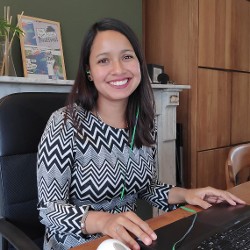
Options Winter 2020: Practically overnight, COVID-19 lockdowns have caused the international research community to move its activities online. What has this meant for IIASA and our ability to produce and communicate research?
 © IIASA
© IIASA
Virtual meetings and remote working have steadily become part of our professional spaces. However, the current pandemic and consequent lockdowns have forced an almost instant digital transformation of our workplaces.
The new normal
A common observation among IIASA researchers
is how easily many face-to-face activities have moved online post-lockdown and how quickly virtual working has become the norm.
“The transition from physical to virtual appeared almost seamless, possibly because everyone wanted it that way. Even those of us with silver hair learned to use the multiple modes for interaction offered by online communication platforms and found the ‘raise hand’ function,” observes IIASA Deputy Director General for Science, Leena Srivastava.
 © IIASA
© IIASA
Keywan Riahi, coordinating lead author on the Intergovernmental Panel on Climate Change (IPCC) Sixth Assessment Report and Energy Program Director was surprised at how effective large-scale virtual meetings can be if they are organized well. "I was in IPCC plenary meetings with more than 250 people logging on at the same time. These online meetings seem to be more productive: parallel threads and discussions can be opened, and while somebody is giving a plenary presentation, others can start real-time discussions in the chat.”
Increased efficiency?
The sense that virtual working leads to improved efficiency is echoed by Caroline Zimm, a researcher with The World in 2050 (TWI2050) initiative. In our third TWI2050 report released earlier this year, we again brought together authors from all over the world. The advantage of moving online was that we were able to meet several times during the writing process, while previously we just had one large in-person meeting. In virtual meetings I experienced people to be more punctual, to stick closer to the agenda, and to give more concise remarks.”
For others, the increased efficiency of going digital is not as clear-cut. Piotr Magnuszewski, a researcher in the Risk and Resilience and Water programs, designs simulations and role-playing games to engage diverse audiences on issues of complexity and sustainability.
 © IIASA
© IIASA
“COVID-19 has had a huge impact on stakeholder engagement as stakeholder events have needed to be redesigned for the virtual world. Building relationships is an important part of these meetings and it is hard to replace face-to-face communication,” he explains. “Careful planning is needed to engage participants beyond typical teleconferences so that they can fully contribute to the discussion and co-creation of results. We used the Miro software to allow large groups to contribute to a joint assessment of climate-related hazards, vulnerabilities, and impacts in Spain.”
Zoom burn out
24/7 online availability has also affected researchers in terms of work-life balance as Joeri Rogelj, a researcher in the Energy Program explains. "One clear limitation of virtual meetings is that truly international collaborative endeavors like the IPCC reports result in calls being scheduled from 6am until midnight for people living in Europe, and even worse hours for people living elsewhere. This can result in a deterioration of a healthy work-life balance and also create barriers to participation.”
Franziska Gaupp, a researcher with the Ecosystems Services and Management Program,
offers a counter balance. “We save a lot of money and time by not travelling in person. Early-career researchers or students with less travel budget can therefore attend conferences more easily. The European Geoscience Union (EGU) conference was free for everyone to attend online this year, and I think a lot of students took advantage of this.”
Michaela Rossini, manager of the Library and Knowledge Resources Unit, points out that while the post-COVID virtual workplace might increase participation for some, several studies suggest that female scientists may be producing less publications as they carry a larger burden of familial responsibilities than their male counterparts do.
A smaller carbon footprint - will it last?
Reduced work-related travel has lessened the environmental impact from scientific meetings, but will the benefits of this be carried forward? Jens Borken-Kleefeld is a researcher with the Air Quality and Greenhouse Gases Program and sees the overnight digitalization as proof that many scientific meetings are possible remotely, while acknowledging that complete virtual working poses significant challenges for certain types of field work.
He is concerned that demand for face-to-face meetings might just surge when restrictions are
lifted. This will be a lost opportunity for change to more sustainable travel practices.
What is clear is that in the longer term, virtual working is here to stay and we need to invest in both better technologies and group processes to make the best of this new situation.
The first virtual Young Scientists Summer Program
 © IIASA
© IIASA
Janet Molina-Maturano participated in the 2020 Young Scientists Summer Program (YSSP), the first to be held online since the program began in 1977. “My experience has been like a rollercoaster. Initially, I experienced some confusion navigating the IIASA structure, acronyms, and platforms in a virtual setting, but IIASA colleagues were always willing to support me “digitally” on both a professional and personal level. There were some exciting moments due to the inspiring research we got to know during the virtual presentations and discussions, but also times of wishing I could get to know people at IIASA and other YSSPers in person. Overall, it has however been a really worthwhile and interesting experience. I highly recommend it!”
By Rachel Potter